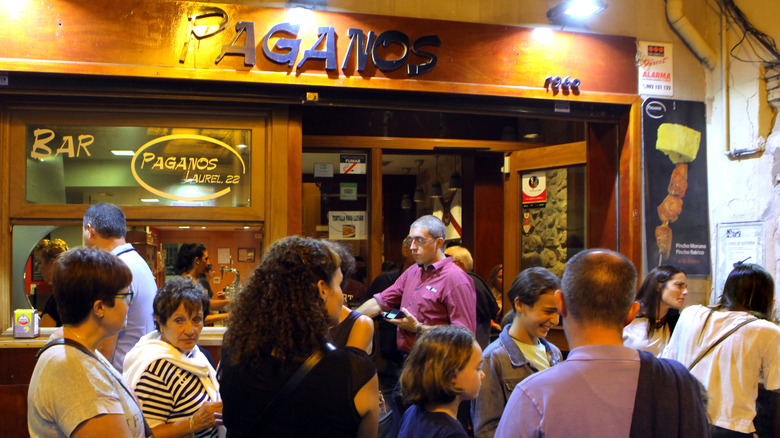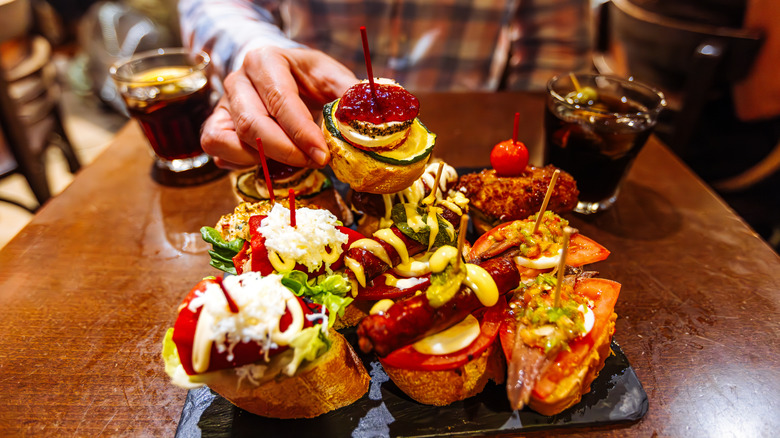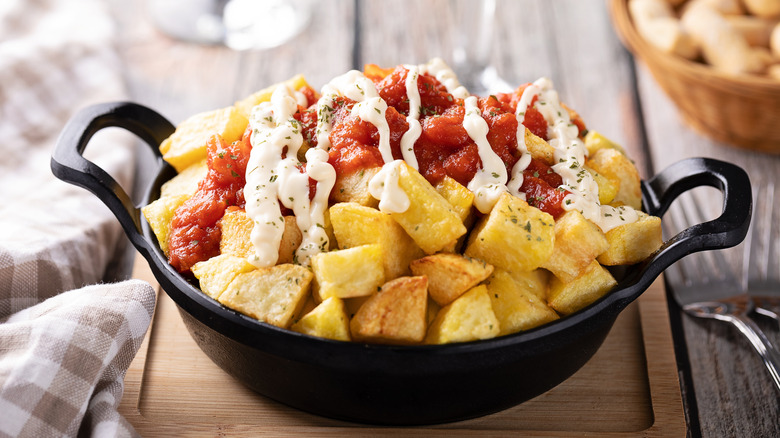Why Tourists Should 'Go Mobile' For Dinner While In The City Of Madrid, Per Rick Steves
Spain exudes so much magic that it's difficult to choose just what it is that makes the country so special. Is it the gorgeous, historical towns — like this undiscovered Andalusian beauty? Or is it the sun-kissed beaches, gorgeous islands, or picturesque natural wonders that makes Spain the best country in Europe for unforgettable road trips?
One thing that draws plenty of people to Spain is its cuisine. From jamón Ibérico to various tapas, pintxos, and of course paella, Spanish food comes from a rich culinary history that makes it a thrilling place to eat, and this especially goes for its capital, Madrid. While you may be tempted to sit down and savor a long meal at one of the 29 Michelin-star restaurants that have helped transform the city into Europe's must-visit food destinations, travel guru Rick Steves suggests another approach.
Instead of just going to one spot, Steves recommends participating in a local tradition called tapeo, which combines bar-hopping and multi-venue grazing, often across whole neighborhoods. According to Steves, he never tires of "this edible scavenger hunt," where he collects "small portions of seafood, salads, meat-filled pastries, and deep-fried tasties, and piece[s] them together for a light evening meal."
Casual sightseeing combined with authentic local cuisine in Madrid
Once a nondescript village, over the centuries Madrid has grown into a major metropolis, and is now home to some 3 million people. Much of the city's core has been developed into thriving car-free districts where — especially in the sizzling months of the summer — locals come out in the evenings, to stroll, socialize, and enjoy cold beer, wine, and tapas at many city establishments.
According to Steves, you can really get a good sense of what makes tapas in Madrid so special by exploring the area that occupies a couple of blocks along Calle de Jesús near the world-famous Prado art museum. This neighborhood is home to plenty of vibrant bars that offer an array terrific tapas and drinks to wash them down.
There are, of course, other spots that anyone keen to head out on a tapas crawl should check out. With over 50 tapas tabernas spread along a 0.2-mile street, Calle de Cava Baja is a slice of tapas heaven, and is within a short striking distance of famous attractions such as la Plaza Mayor. Cava Alta and Humilladeros are two other neighborhoods known for their concentrations of old-school establishments. And the historical Mercado de San Miguel is also a perfect place to graze, with over 20 food stalls serving up a variety of dishes (plus it's easy to find a seat).
A quick menu guide to tapas in Madrid
Now that you know where to go on your Madrid tapeo, the question is: What should you order? After all, tapas come in many varieties, so knowing what to select depends not just on your personal taste, but other factors such as the season, regional delicacies, and what that particular establishment happens to do well.
Perhaps Madrid's most fundamental tapa is patatas bravas, which is crispy, fried potatoes in a spicy red sauce. Other popular bar snacks in the capital include gambas al ajillo (shrimp sauteed in garlic), tortilla Española (a potato and onion omelet), croquetas (fritters often filled with ham and cheese), callos a la Madrileña (tripe soup), gazpacho (cold tomato soup), bocadillo de calamares (squid sandwich), and small green peppers called pimientos de padrón.
When it comes to drinks, that is largely up to you, though wine is the go-to accompaniment with a lot of tapas. Dishes using a lot of tomato pair well with light reds, while cheeses, seafood, and most fried tapas match with dry whites, Sherry, or Cava — Spain's answer to Champagne. Of course cold suds are usually a good choice as well, though if you wish to impress your bartender, here is the way to order a beer in Spain.


